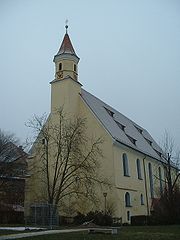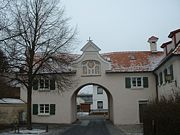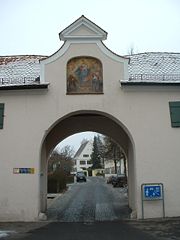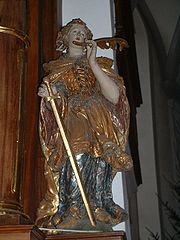
Söflingen Abbey
Encyclopedia







Order of Poor Ladies
The Poor Clares also known as the Order of Saint Clare, the Order of Poor Ladies, the Poor Clare Sisters, the Clarisse, the Minoresses, the Franciscan Clarist Congregation, and the Second Order of St. Francis, , comprise several orders of nuns in the Catholic Church...
, also known as the Poor Clares, the Poor Clare Sisters, the Clarisse, the Minoresses, or the Second Order of St. Francis. It was situated in the village of Söflingen, now part of Ulm
Ulm
Ulm is a city in the federal German state of Baden-Württemberg, situated on the River Danube. The city, whose population is estimated at 120,000 , forms an urban district of its own and is the administrative seat of the Alb-Donau district. Ulm, founded around 850, is rich in history and...
in Baden-Württemberg
Baden-Württemberg
Baden-Württemberg is one of the 16 states of Germany. Baden-Württemberg is in the southwestern part of the country to the east of the Upper Rhine, and is the third largest in both area and population of Germany's sixteen states, with an area of and 10.7 million inhabitants...
, Germany
Germany
Germany , officially the Federal Republic of Germany , is a federal parliamentary republic in Europe. The country consists of 16 states while the capital and largest city is Berlin. Germany covers an area of 357,021 km2 and has a largely temperate seasonal climate...
. Being the oldest nunnery of this order in Germany, it was also its most important and most affluent.
Foundation
Söflingen Abbey originated from a pre-FranciscanFranciscan
Most Franciscans are members of Roman Catholic religious orders founded by Saint Francis of Assisi. Besides Roman Catholic communities, there are also Old Catholic, Anglican, Lutheran, ecumenical and Non-denominational Franciscan communities....
congregation of women that had acquired the rights over three farmsteads close to the river Danube
Danube
The Danube is a river in the Central Europe and the Europe's second longest river after the Volga. It is classified as an international waterway....
near Ulm. It was for the first time mentioned in 1237.
Soon the original location became inadequate being too small to house a growing number of nuns. Its exposed position close to the river Danube also meant that it was vulnerable during the political upheaval in the reign of Emperor
Holy Roman Emperor
The Holy Roman Emperor is a term used by historians to denote a medieval ruler who, as German King, had also received the title of "Emperor of the Romans" from the Pope...
Frederick II
Frederick II, Holy Roman Emperor
Frederick II , was one of the most powerful Holy Roman Emperors of the Middle Ages and head of the House of Hohenstaufen. His political and cultural ambitions, based in Sicily and stretching through Italy to Germany, and even to Jerusalem, were enormous...
and before 1253 a decision was made to move the congregation to Söflingen. In 1254 and in 1259 Hailwigis (Hedwig) was mentioned as being the first abbess
Abbess
An abbess is the female superior, or mother superior, of a community of nuns, often an abbey....
. At the same time, in 1252, nuns from Söflingen and Ulm were sent out Abbey to found a new convent
Convent
A convent is either a community of priests, religious brothers, religious sisters, or nuns, or the building used by the community, particularly in the Roman Catholic Church and in the Anglican Communion...
at Pfullingen (also near Ulm). The relocation to Söflingen was actively assisted by Countess Willibirgis of Helfenstein, a member of the noble family of Dillingen by birth, and finally confirmed when, on 13 January 1258, Hartmann IV, Count of Dillingen, signed a charter
Charter
A charter is the grant of authority or rights, stating that the granter formally recognizes the prerogative of the recipient to exercise the rights specified...
donating lands at Sevelingen, previously owned by the counts of Dillingen, to the nuns in order to found a monastery there.
Development
After initially accepting the rule for the Second Order of St Francis of AssisiFrancis of Assisi
Saint Francis of Assisi was an Italian Catholic friar and preacher. He founded the men's Franciscan Order, the women’s Order of St. Clare, and the lay Third Order of Saint Francis. St...
as laid down by Pope Gregory IX
Pope Gregory IX
Pope Gregory IX, born Ugolino di Conti, was pope from March 19, 1227 to August 22, 1241.The successor of Pope Honorius III , he fully inherited the traditions of Pope Gregory VII and of his uncle Pope Innocent III , and zealously continued their policy of Papal supremacy.-Early life:Ugolino was...
, the nuns accepted the amendments by Pope Innocent IV
Pope Innocent IV
Pope Innocent IV , born Sinibaldo Fieschi, was pope from June 25, 1243 until his death in 1254.-Early life:...
only to finally follow the rules as promulgated by Pope Urban IV
Pope Urban IV
Pope Urban IV , born Jacques Pantaléon, was Pope, from 1261 to 1264. He was not a cardinal, and there have been several Popes since him who have not been Cardinals, including Urban V and Urban VI.-Biography:...
(1261–64). When exactly this happened is not known. However, the monastery followed this rule in the 14th century.
From its very beginning, Söflingen Abbey was under the ecclesiastical protection of the Papal See
Holy See
The Holy See is the episcopal jurisdiction of the Catholic Church in Rome, in which its Bishop is commonly known as the Pope. It is the preeminent episcopal see of the Catholic Church, forming the central government of the Church. As such, diplomatically, and in other spheres the Holy See acts and...
. This was confirmed several times by privileges issued by Innocent IV and Alexander IV
Pope Alexander IV
Pope Alexander IV was Pope from 1254 until his death.Born as Rinaldo di Jenne, in Jenne , he was, on his mother's side, a member of the de' Conti di Segni family, the counts of Segni, like Pope Innocent III and Pope Gregory IX...
(1254–61). The latter also relieved them from the duty to pay taxes to the papacy due to the nuns' oath of poverty. Pope Nicholas III
Pope Nicholas III
Pope Nicholas III , born Giovanni Gaetano Orsini, Pope from November 25, 1277 to his death in 1280, was a Roman nobleman who had served under eight Popes, been made cardinal-deacon of St...
(1277–80) widened this protection to include all the subjects and all the possessions of Söflingen Abbey. Finally, Pope John XXII
Pope John XXII
Pope John XXII , born Jacques Duèze , was pope from 1316 to 1334. He was the second Pope of the Avignon Papacy , elected by a conclave in Lyon assembled by Philip V of France...
(1316–34) explicitly appointed the Bishop of Constance as the official protector of the nunnery.
The task of secular protection passed at first from the Emperor Conrad IV
Conrad IV of Germany
Conrad IV was king of Jerusalem , of Germany , and of Sicily .-Biography:...
to the Counts of Dillingen. In 1356, however, Emperor Charles IV
Charles IV, Holy Roman Emperor
Charles IV , born Wenceslaus , was the second king of Bohemia from the House of Luxembourg, and the first king of Bohemia to also become Holy Roman Emperor....
put the abbey under the secular protection of the Free Imperial City
Free Imperial City
In the Holy Roman Empire, a free imperial city was a city formally ruled by the emperor only — as opposed to the majority of cities in the Empire, which were governed by one of the many princes of the Empire, such as dukes or prince-bishops...
of Ulm but confirmed many of its rights in 1368, especially the rights of advocacy
Vogt
A Vogt ; plural Vögte; Dutch voogd; Danish foged; ; ultimately from Latin [ad]vocatus) in the Holy Roman Empire was the German title of a reeve or advocate, an overlord exerting guardianship or military protection as well as secular justice...
.
During the Middle Ages
Middle Ages
The Middle Ages is a periodization of European history from the 5th century to the 15th century. The Middle Ages follows the fall of the Western Roman Empire in 476 and precedes the Early Modern Era. It is the middle period of a three-period division of Western history: Classic, Medieval and Modern...
the monastery not only owned possessions in the vicinity of Söflingen and Ulm but also had ownership over numerous villages stretching as far as Gomaringen
Gomaringen
Gomaringen is a municipality located about 10 km south of Tübingen in the German state of Baden-Württemberg.-Geographical Position:Gomaringen is located in the valley of the stream Wiesaz, a tributary of the Steinlach, which in turn flows into the Neckar....
near Tübingen
Tübingen
Tübingen is a traditional university town in central Baden-Württemberg, Germany. It is situated south of the state capital, Stuttgart, on a ridge between the Neckar and Ammer rivers.-Geography:...
and, transcending the boundaries of the Diocese of Constance
Bishopric of Constance
The Bishopric of Constance was a diocese of the Roman Catholic Church and ecclesiastical state of the Holy Roman Empire that existed from about 585 until 1821. Its seat was Konstanz at the western end of Lake Constance in the south-west corner of Germany...
, even into the Diocese of Augsburg
Prince-Bishopric of Augsburg
The Prince-Bishopric of Augsburg was one of the prince-bishoprics of the Holy Roman Empire, which belonged to the Swabian Circle.-Early period:...
. Since 1239 Söflingen Abbey owned vineyards in Neuffen
Neuffen
Neuffen is a town in the district of Esslingen, in Baden-Württemberg in southern Germany.-Geography:It is located 14 km northeast of Reutlingen, and 28 km southeast of Stuttgart....
and later acquired vineyards in Heimbach, Beutelsbach, Großheppach, Schnait (all near Weinstadt
Weinstadt
Weinstadt is a town in the county Rems-Murr, in the state of Baden-Württemberg, Germany. It is located in the Rems Valley approximately 15 km east of Stuttgart. As the name implies, it is best known for its vineyards and production of wine...
) and Stuttgart
Stuttgart
Stuttgart is the capital of the state of Baden-Württemberg in southern Germany. The sixth-largest city in Germany, Stuttgart has a population of 600,038 while the metropolitan area has a population of 5.3 million ....
. With the acquisition of the local fortress, a process began which culminated in the whole village of Söflingen coming into the possession of the abbey around 1270. In 1392 Söflingen Abbey issued a set of laws for the village of Söflingen, an indication of how the idea of rule was changing, away from mere authority of a restricted, local area and towards authority over a wider range of territory.
In the 15th century, an echo of the mysticism
Mysticism
Mysticism is the knowledge of, and especially the personal experience of, states of consciousness, i.e. levels of being, beyond normal human perception, including experience and even communion with a supreme being.-Classical origins:...
of the 13th and 14th century became to characterise the spiritual life of the monastery as witnessed by the Söflinger Briefe and the Söflinger Lieder. These letters and songs document an increasing tendency towards spiritualisation and a more poetic approach of piety. A further expression of this change is the reform of the abbey which was completed with the replacement of Abbess Christina Strölin (1469–84) by the reform-oriented Abbess Elisabeth Reichner (1484–1508/13) and the rebuilding of the abbey under the latter when not only the ecclesiastical buildings were either rebuilt or renewed but also had a wall surrounding the monastery added.
During the Protestant Reformation
Protestant Reformation
The Protestant Reformation was a 16th-century split within Western Christianity initiated by Martin Luther, John Calvin and other early Protestants. The efforts of the self-described "reformers", who objected to the doctrines, rituals and ecclesiastical structure of the Roman Catholic Church, led...
Söflingen Abbey came into conflict with the Imperial City of Ulm which had accepted Protestantism in 1529. The abbey endeavoured to defend Catholicism and to preserve its political independence. The nuns were supported by Emperor Charles V
Charles V, Holy Roman Emperor
Charles V was ruler of the Holy Roman Empire from 1519 and, as Charles I, of the Spanish Empire from 1516 until his voluntary retirement and abdication in favor of his younger brother Ferdinand I and his son Philip II in 1556.As...
who repeatedly prohibited Ulm to abuse its right of protection over the abbey. At the same time the emperor appointed the Bishops of Augsburg and Constance as ecclesiastical protectors. Ulm's city council, on the other hand, forbade its citizens to attend mass at the abbey. In 1537 Ulm unsuccessfully tried to install a Protestant priest in Söflingen and to introduce Protestantism between 1543 and 1548.
From this time on, Söflingen Abbey attempted to discard Ulm's protection and claimed Imperial immediacy, which they achieved only much later, and kept repelling Protestant influences. In 1566 and 1576 abbey was given a seat at the Imperial Diet
Reichstag (Holy Roman Empire)
The Imperial Diet was the Diet, or general assembly, of the Imperial Estates of the Holy Roman Empire.During the period of the Empire, which lasted formally until 1806, the Diet was not a parliament in today's sense; instead, it was an assembly of the various estates of the realm...
.
During the Thirty Years War, the abbey suffered from the armies of the Protestant Union
Protestant Union
The Protestant Union or Evangelical Union was a coalition of Protestant German states that was formed in 1608 to defend the rights, lands and person of each member....
as well as those from the Catholic League
Catholic League (German)
The German Catholic League was initially a loose confederation of Roman Catholic German states formed on July 10, 1609 to counteract the Protestant Union , whereby the participating states concluded an alliance "for the defence of the Catholic religion and peace within the Empire." Modeled...
. In 1628, Swedish troops pillaged the abbey and from 1643 until 1647 Swedish troops used the abbey as a permanent base. During these years, the nuns from the abbey sought refuge behind the protective walls of Ulm. Söflingen Abbey was to be used as headquarters for troops again in the 18th century during the War of the Spanish Succession
War of the Spanish Succession
The War of the Spanish Succession was fought among several European powers, including a divided Spain, over the possible unification of the Kingdoms of Spain and France under one Bourbon monarch. As France and Spain were among the most powerful states of Europe, such a unification would have...
, this time by Maximilian II Emanuel, Elector of Bavaria
Maximilian II Emanuel, Elector of Bavaria
Maximilian II , also known as Max Emanuel or Maximilian Emanuel, was a Wittelsbach ruler of Bavaria and an elector of the Holy Roman Empire. He was also the last Governor of the Spanish Netherlands and duke of Luxembourg...
, in 1701 and in 1704 by the Duke of Marlborough
John Churchill, 1st Duke of Marlborough
John Churchill, 1st Duke of Marlborough, Prince of Mindelheim, KG, PC , was an English soldier and statesman whose career spanned the reigns of five monarchs through the late 17th and early 18th centuries...
. During the Napoleonic Wars
Napoleonic Wars
The Napoleonic Wars were a series of wars declared against Napoleon's French Empire by opposing coalitions that ran from 1803 to 1815. As a continuation of the wars sparked by the French Revolution of 1789, they revolutionised European armies and played out on an unprecedented scale, mainly due to...
, Michel Ney set up his headquarters at the abbey in 1805.
After the end of the Thirty Years War in 1648 it took some decades before the general recovery made itself felt at Söflingen Abbey. Under the rule of abbesses Euphrosinia Rampf (1684–1687), Kleopha Veeser (1687) and Angela Gräfin Slawata (1687–1701) the abbey church was rebuilt in early Baroque
Baroque architecture
Baroque architecture is a term used to describe the building style of the Baroque era, begun in late sixteenth century Italy, that took the Roman vocabulary of Renaissance architecture and used it in a new rhetorical and theatrical fashion, often to express the triumph of the Catholic Church and...
style. The building was designed and erected under the supervision of architect
Architect
An architect is a person trained in the planning, design and oversight of the construction of buildings. To practice architecture means to offer or render services in connection with the design and construction of a building, or group of buildings and the space within the site surrounding the...
Kaspar Feichtmayr from Wessobrunn
Wessobrunn
Wessobrunn is a municipality in the district of Weilheim-Schongau in Bavaria in Germany.-Paterzell airfield:Paterzell airfield is located in Wessobrunn. The local aeroclub Luftsportverein Weilheim-Peißenberg competes in glider aerobatics. The German National Champion in 2006, Markus Feyerabend...
.
In the 18th century Söflingen Abbey owned the villages of Söflingen, Harthausen and Schaffelkingen (now all part of the city of Ulm) as well as parts of the villages of Bettingen, Burlafingen and Eckingen. In several other villages mostly belonging to the Imperial City of Ulm, the abbey had the right to levy certain taxes and was in possession of estates there. In 1773 the abbey reached a legal settlement with the city of Ulm whereby it relinquished its rights on the villages of Mähringen, Lehr, Jungingen
Ulm-Jungingen
Ulm-Jungingen is a borough of Ulm in the German Bundesland of Baden-Württemberg with a population around 3,200.- History :Historians suppose that the first settlers arrived circa 700. The ending "ingen" insinuates that Jungingen, like its namesake to the west near the river Neckar, has an alemannic...
, Breitingen
Breitingen
Breitingen is a municipality in the district of Alb-Donau in Baden-Württemberg in Germany....
, Holzkirch
Holzkirch
Holzkirch is a town in the district of Alb-Donau in Baden-Württemberg in Germany....
, Lonsee
Lonsee
Lonsee is a town in the Alb-Donau district in Baden-Württemberg in Germany.The population of Lonsee in 2008 is 4.758; the town consists of 7 villages - Ettlenschiess, Halzhausen, Sinabronn, Lonsee, Luizhausen and Urspring...
, Langenau
Langenau
Langenau is a town in the district of Alb-Donau in Baden-Württemberg in Germany. It is situated 14 km northeast of Ulm.-Transport:Langenau is located directly on the Autobahn A7 and near the A8...
, Weidenstetten
Weidenstetten
Weidenstetten is a town in the district of Alb-Donau in Baden-Württemberg in Germany....
, Söglingen and Bermaringen. In exchange for this Ulm, which had been Protestant
Protestantism
Protestantism is one of the three major groupings within Christianity. It is a movement that began in Germany in the early 16th century as a reaction against medieval Roman Catholic doctrines and practices, especially in regards to salvation, justification, and ecclesiology.The doctrines of the...
since the first half of the 16th century, gave up its protection, territorial and legal rights over Söflingen Abbey. At the same time, the abbey finally achieved Imperial immediacy with the abbess receiving a seat and voting rights in the Swabian Circle
Swabian Circle
The Swabian Circle was an Imperial Circle of the Holy Roman Empire established in 1500 on the territory of the former German stem-duchy of Swabia. However, it did not include the Habsburg home territories of Swabian Austria, the member states of the Swiss Confederacy nor the lands of the Alsace...
and the Reichstag
Reichstag (Holy Roman Empire)
The Imperial Diet was the Diet, or general assembly, of the Imperial Estates of the Holy Roman Empire.During the period of the Empire, which lasted formally until 1806, the Diet was not a parliament in today's sense; instead, it was an assembly of the various estates of the realm...
.
Dissolution
During the secularisation of ecclesiastical states the territory and property of Söflingen Abbey with its 4000 subjects came under BavariaElectorate of Bavaria
The Electorate of Bavaria was an independent hereditary electorate of the Holy Roman Empire from 1623 to 1806, when it was succeeded by the Kingdom of Bavaria....
n rule. Together with the nuns the last abbess, Bonaventura Seelinger, chose to continue the monastic life but had to leave the monastery after all in 1809 when the buildings were used as an army hospital and later as a Royal Bavarian
Kingdom of Bavaria
The Kingdom of Bavaria was a German state that existed from 1806 to 1918. The Bavarian Elector Maximilian IV Joseph of the House of Wittelsbach became the first King of Bavaria in 1806 as Maximilian I Joseph. The monarchy would remain held by the Wittelsbachs until the kingdom's dissolution in 1918...
court of law only to be allowed to briefly return in 1810 when, following a border treaty between Württemberg
Württemberg
Württemberg , formerly known as Wirtemberg or Wurtemberg, is an area and a former state in southwestern Germany, including parts of the regions Swabia and Franconia....
and Bavaria in 1810, the area around Söflingen, together with Ulm, came under the rule of the recently founded Kingdom of Württemberg. Monastic life finally came to an end in 1814 when the buildings were again used as a hospital, this time for the Württemberg army. The abbey's possessions were largely sold off into private hands. Most of the monastic buildings were demolished and the abbey church became the parish church of Söflingen.
Further reading
- Frank, Karl Suso (1979), "Das Klarissenkloster Söflingen bis zur Aufhebung 1803" in: Kirchen und Klöster in Ulm. Ein Beitrag zum katholischen Leben in Ulm und Neu-Ulm von den Anfängen bis zur Gegenwart, Hans Eugen Specker (ed.), pp. 163–199, Ulm: Süddeutsche Verlagsgesellschaft, ISBN 3-8829-4019-0

